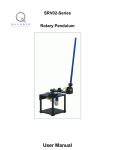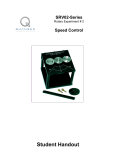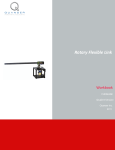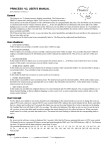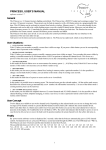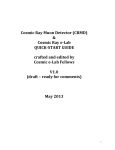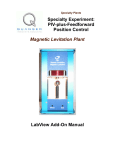Download Rotary Flexible Link
Transcript
SRV02-Series Rotary Flexible Link User Manual Table of Contents 1. 2. 3. 4. 6. Description................................................................................................................................3 1.1 Modular Options....................................................................................................................4 System Nomenclature and Components...................................................................................5 System Setup and Assembly.....................................................................................................6 3.1 Typical Connections for the SRV02 – FLEXGAGE Experiment.........................................7 3.2 Calibrating the Strain Gage....................................................................................................7 3.2.1. Offset Adjustment..............................................................................................................8 3.2.2. Gain Adjustment................................................................................................................8 Rotary Flexible Link Module – Range of Experiments & Features.......................................10 System Requirements & Specifications..................................................................................11 6.1 System Specifications..........................................................................................................11 Index of Tables Table 1 - Rotary Family Modules.......................................................................................................4 Table 2 - Component Names..............................................................................................................5 Table 3 - Typical Connections............................................................................................................7 Table 4 - System Requirements........................................................................................................11 Table 5 - FLEXGAGE Specifications..............................................................................................11 Index of Figures Figure 1 - FLEXGAGE coupled to SRV02........................................................................................5 Figure 2 - Strain gage close up...........................................................................................................5 Figure 3 - Contents of FLEXGAGE package.....................................................................................6 Figure 4 - Attaching to the SRV02....................................................................................................6 Figure 5 - Place tip in middle slot.......................................................................................................8 Figure 6 - Move tip 4 slots counter clockwise....................................................................................9 Page # 2 Revision: 01 SRV02-Series FLEXGAGE - Rotary Flexible Link User Manual 1. Description The rotary flexible Link consists of a strain gage which is mounted at the clamped end of a thin stainless steel flexible link. The output is an analog signal proportional to the deflection of the link. The system is designed to mount on a Quanser rotary servo plant resulting in a horizontally rotating flexible link to perform flexible link control experiments. This system is similar in nature to the control problems encountered in large light space structures where the weight constraints result in flexible structures that must be controlled using feedback techniques. A DC motor rotates a flexible link from one end in the horizontal plane. The motor end of the link is instrumented with a strain gage that can detect the deflection of the tip. The rotary flexible Link is an ideal experiment intended to model a flexible Link on a robot or spacecraft. This experiment is also useful in the study of vibration analysis and resonance. Page # 3 Revision: 01 1.1 Modular Options Quanser values itself for the modularity of its experiments. The SRV02 rotary plant module serves as the base component for the rotary family of experiments. This modular philosophy facilitates the change from one experimental setup to another with relative ease of work and a valuable savings in cost. The following table lists the experiments currently available in the rotary family of products utilizing the SRV02 as the base. Module Name Description Ball & Beam The Ball & Beam experiment requires the user to manipulate the position of a rolling ball on a beam. Flexible Link The Flexible Link experiment requires the user to command a tip position of the flexible link attached to the SRV02. Flexible Joint A rigid beam is mounted on a flexible joint that rotates via the SRV02 and the user is to command the tip position of this beam. Gyro/Stable Platform The purpose is to maintain the line of sight of an instrument mounted on a rotating platform (SRV02). Inverted Pendulum The purpose is to balance the inverted pendulum through a rotary motion arm (SRV02). Double Inverted Pendulum The double inverted problem adds to the complexity of the single pendulum by introducing a 2nd pendulum. 2 DOF robot module This experiment requires the x-y positioning of the “end effector”. 2 DOF Rotary Gantry This experiment requires the control of the swing of a x-y gantry crane using a 5 DOF linkage. 2 DOF inverted pendulum Balance a pendulum that is free to fall in 2 directions. The pendulum is attached to the tip of the 2 DOF robot. Table 1 - Rotary Family Modules Page # 4 Revision: 01 2. System Nomenclature and Components Figure 1 & Figure 2 below depict the FLEXGAGE module. The standard FLEXGAGE is equipped with a strain gage sensor resulting in an analog signal proportional to the deflection of the tip. Refer to the following table to associate the components with their corresponding photographs. 1 SRV02 Base 5 Strain gage circuit 2 FLEXGAGE module 6 Thumbscrews 3 FLEXGAGE Link 7 Sensor connector 4 Strain gage Table 2 - Component Names 3 2 7 1 Figure 1 - FLEXGAGE coupled to SRV02 5 4 6 Figure 2 - Strain gage close up Page # 5 Revision: 01 3. System Setup and Assembly The rotary flexible Link module requires minimal assembly. Figure 3 Below shows the components of the FLEXGAGE package you should have received. The FLEXGAGE package includes the module itself, a calibration stand and the sensor wire *Note the FLEXGAGE is already pre-calibrated to the correct settings. Figure 3 - Contents of FLEXGAGE package The only assembly required is to mount the FLEXGAGE onto the SRV02. Make sure the SRV02 is configured in the High-Gear configuration. If you are unsure about the SRV02, please refer to the SRV02 User Guide. Simply place the FLEXGAGE onto the load shaft (middle shaft) and secure the FLEXGAGE in place by tightening the 2 thumbscrews as seen in Figure 4 below. Figure 4 - Attaching to the SRV02 Page # 6 Revision: 01 3.1 Typical Connections for the SRV02 – FLEXGAGE Experiment The following table describes the typical setup using the complete Quanser solution. It is assumed that the FLEXGAGE is being used along with an SRV02, UPM and Q8 DAQ board. From... FLEXGAGE Strain Gage (Component 4) To... S2 Connector on UPM. Cable Description 6-pin mini This cable results in delivering a ±12V bias DIN to 6-pin to the potentiometer and measuring the mini DIN. potentiometer signal voltage on S2 of the UPM. Encoder 0 *This is the load gear connector on position measurement the terminal board. 5-pin Stereo The terminal board should supply the DIN to 5-pin encoder with the +5V and ground. The load Stereo DIN. shaft position signal will then be measure on Encoder channel 0. 'To Load' Connector on UPM. Motor on SRV02. 6-pin DIN to This connects the output of the amplifier to 4-pin DIN. the motor. You can use a variety of cables resulting in a different gain from input to output. The cables available are Gain=1, Gain=3, Gain=5. Analog Signals (To A/D) Analog input channels 0-3 on the DAQ. 5-pin DIN to From the UPM, connect all the analog 4x RCA. sensor signals to the terminal board such that S1 is measured on analog input 0. S2 AI # 1, S3 - AI # 2, S4 - AI # 3. Analog output channel 0 on the DAQ. UPM input (From D/A) RCA to 5-pin This is the command output from the DAQ DIN. that will be amplified and drive the motor. SRV02 Encoder Table 3 - Typical Connections 3.2 Calibrating the Strain Gage The FLEXGAGE uses a strain gage mounted at the base of the link to measure the deflection of the tip of the link. Before the module is shipped, the unit would have been fully calibrated to the correct specifications. The following section will describe the calibration routine in order to ensure the unit maintains its correct calibration and thus remains operating correctly. This section describes functional tests to determine if your FLEXGAGE sensors are operating normally. It does not cover any performance tests. All these tests require an understanding of Simulink (or Labview), WinCon (or equivalent), and Q8 (or equivalent data acquisition board you are using). You should be able to “build” a controller that can measure and apply desired signals. Page # 7 Revision: 01 In the following sections, it is also assumed that the FLEXGAGE is connected as described in the Typical Connections table above. As you can see in Figure 4 above, the FLEXGAGE circuit has 2 adjustable potentiometers. One is for the Offset adjustment and the other is for the Gain adjustment. Build a controller that displays the measurement from analog input # 1 (This is the signal connected to S2 on the UPM). 3.2.1. Offset Adjustment Mount the FLEXGAGE onto the calibration stand that shipped with the module. Place the tip in the middle tooth of the comb as seen in Figure 5 below. Figure 5 - Place tip in middle slot Your controller should be running and reading 0 Volts. If there is an offset in your measurement, adjust the Offset potentiometer such that your measurement reads 0 volts. 3.2.2. Gain Adjustment After adjusting the measurement to its 0 measurement, you should check and make sure the sensor is calibrated as desired. The sensor should read 1 Volt per 1 inch of tip deflection. Each slot or tooth in the calibration comb corresponds to ¼ inch displacement. Move the tip counter-clockwise 4 slots as seen in Figure 6 below. Page # 8 Revision: 01 Figure 6 - Move tip 4 slots counter clockwise Your measurement should now be reading 1 volt. If you do not read 1 volt, gently adjust the Gain potentiometer such that you are reading 1 volt. *It is strongly urged to NOT adjust the gain potentiometer too much as the system should have already been calibrated and should not have drifted a significant amount. Once you are reading 1 volt, move the tip 8 slots clockwise (4 slots away from 0) and check that you are now reading -1 volts. After ensuring that your sensor is generating 1 volt / 1 inch deflection, you return the tip to its equilibrium (0) postion and make sure it is again reading 0 volts. If not, adjust the offset potentiometer once again to read 0 volts. *As mentioned above, the unit is already calibrated before shipping and any adjustment would only be minor if any. This calibration routine is only provided for extreme circumstances. For technical support referring to any of the FLEXGAGE components, please visit us on the web at: www.Quanser.com. Under our Technical Support section, please fill out a technical support form indicating your problem in detail and one of our engineers will be happy to respond to your request. Page # 9 Revision: 01 4. Rotary Flexible Link Module – Range of Experiments & Features The rotary flexible Link is an ideal experiment intended to model a flexible Link on a robot or spacecraft. This experiment is also useful in the study of vibration analysis and resonance. The model is designed to accentuate the effects of flexible links in robot control systems. Such flexibility is common in lightweight robots designed for space applications. The students will be exposed to control the vibrations in the link as well as dealing with higher modes of vibration. FLEXGAGE Key Features: • • • • • • • High Quality Aluminum chassis with precision crafted parts High Resolution Strain Gage to sense link deflection Fully documented system models & parameters Fast and Easy attachment to the SRV02 plant Open Architecture Facilitates Matlab/Simulink Design Modular Design Optional High Precision Light Sensor Curriculum Topics: • • • • • • • • • System Modeling & Simulation Real-Time Control Full-State Feedback Frequency Analysis Vibration & Resonance Hardware in the Loop Robotics Observer Design Nonlinear Control Page # 10 Revision: 01 6. System Requirements & Specifications The Rotary Flexible Link Module (FLEXGAGE) is designed as an attachment to the SRV02 plant. Along with the SRV02 plant, the following components are required to complete the experimental setup. Component Quanser Recommended (Common Configuration) Power Module Quanser UPM 1503/2405 Data Acquisition Quanser Q8 Alternative Other Power Supply that can deliver the required power. dSPACE DS 1104 National Instruments E-Series DAQs Any other DAQ with at least one A/D, one D/A and one Encoder input. Quanser WinCon / SLX / WebLab The Mathworks – RTWT, xPC Control Software dSPACE – ControlDesk National Instruments – Labview RT Table 4 - System Requirements 6.1 System Specifications Specification Value Units Module Dimensions 48 x 2 cm2 Flexible Link Length 30 cm Strain Gage Bias Power ±12 Volts Strain Gage Measurement Range ±5 Volts Strain Gage Calibration Gain 1 Volts/Inch Flexible Link mass 0.065 kg Flexible Link rigid body inertia 0.005 kgm2 Equivalent Link Stiffness 0.5 Nm/rad Fundamental Natural Frequency 3.2 Hz Table 5 - FLEXGAGE Specifications Page # 11 Revision: 01














